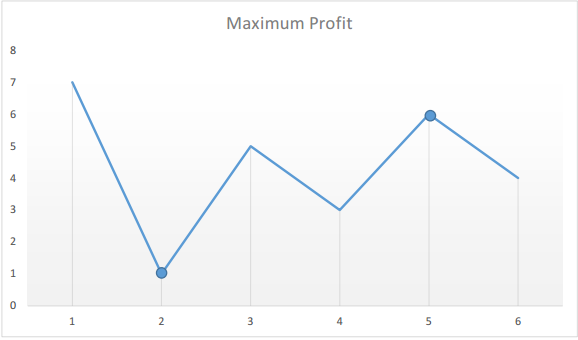All leaked interview problems are collected from Internet.
121. Best Time to Buy and Sell Stock
Say you have an array for which the ith element is the price of a given stock on day i.
If you were only permitted to complete at most one transaction (ie, buy one and sell one share of the stock), design an algorithm to find the maximum profit.
Example 1:
Input: [7, 1, 5, 3, 6, 4] Output: 5 max. difference = 6-1 = 5 (not 7-1 = 6, as selling price needs to be larger than buying price)
Example 2:
Input: [7, 6, 4, 3, 1] Output: 0 In this case, no transaction is done, i.e. max profit = 0.
b'
Solution
\nWe need to find out the maximum difference (which will be the maximum profit) between two numbers in the given array. Also, the second number (selling price) must be larger than the first one (buying price).
\nIn formal terms, we need to find , for every and such that .
\n\n
Approach #1 (Brute Force) [Time Limit Exceeded]
\nJava
\npublic class Solution {\n public int maxProfit(int prices[]) {\n int maxprofit = 0;\n for (int i = 0; i < prices.length - 1; i++) {\n for (int j = i + 1; j < prices.length; j++) {\n int profit = prices[j] - prices[i];\n if (profit > maxprofit)\n maxprofit = profit;\n }\n }\n return maxprofit;\n }\n}\n
Complexity Analysis
\n- \n
- Time complexity : . Loop runs times. \n
- Space complexity : . Only two variables - maxprofit and profit are used. \n
\n
Approach #2 (One Pass) [Accepted]
\nAlgorithm
\nSay the given array is:
\n[7, 1, 5, 3, 6, 4]
\nIf we plot the numbers of the given array on a graph, we get:
\n
The points of interest are the peaks and valleys in the given graph. We need to find the largest peak following the smallest valley.\nWe can maintain two variables - minprice and maxprofit corresponding to the smallest valley and maximum profit (maximum difference between selling price and minprice) obtained so far respectively.
\nJava
\npublic class Solution {\n public int maxProfit(int prices[]) {\n int minprice = Integer.MAX_VALUE;\n int maxprofit = 0;\n for (int i = 0; i < prices.length; i++) {\n if (prices[i] < minprice)\n minprice = prices[i];\n else if (prices[i] - minprice > maxprofit)\n maxprofit = prices[i] - minprice;\n }\n return maxprofit;\n }\n}\n
Complexity Analysis
\n- \n
- \n
Time complexity : . Only a single pass is needed.
\n \n - \n
Space complexity : . Only two variables are used.
\n \n
Analysis written by: @vinod23
\n